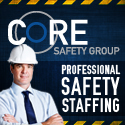| |
Contact Us Archives
Subscribe Printer-Friendly AdvertiseSafety and HealthFacebook 
|
|
Spice Up Those Safety Meetings
 Print this Article | Send to Colleague Print this Article | Send to Colleague
By Robert K. Tuman
Construction Safety Consultant and OSHA Outreach Trainer
“Ugh! Another safety meeting?” This is the mournful cry often heard before yet another boring, nap-inducing toolbox talk.
Some toolbox talks, especially those where the presenter reads from a boilerplate, irrelevant (e.g., a recitation of winter weather safety tips at a Palm Beach, Fla. jobsite) safety meeting script, are a waste of time and money.
If toolbox talks are to be effective, they should:
- Raise awareness of unsafe conditions and lead to corrective action
- Raise awareness, without identifying violating employees, of unsafe behavior and result in corrective action
- Introduce new safety guidelines and OSHA regulations
- Reinforce safety guidelines
- Motivate workers to comply with generally accepted safe work practices
- Help to internalize an appreciation of safety and the company’s and individual employees’ roles in keeping themselves healthy and safe
To make toolbox talks and safety meetings enjoyable, interesting and informative, and to motivate workers to actively participate, follow these tips:
- Encourage the leader and workers to discuss the most reckless thing(s) they’ve ever done.
- Engage workers. For example, masons might hold the meeting at or on their staging. The foreman should ask workers what they think of the staging from a safety standpoint, and what they would do, if anything, to improve scaffolding safety.
- Use the jobsite as your toolbox talk laboratory. Jobsites are fertile territory for visual examples of compliance or lack of compliance in areas such as fall protection, trench safety, personal protective equipment, electrical safety, and scaffold safety. Ask employees to point out unsafe conditions and/or unsafe behavior, and encourage them to discuss the corrective actions they would take, if any.
- Provide workers with a safety inspection checklist and ask them to walk around their work area prior to meetings and bring their safety observations for discussion.
- Pass around safety-related photos (search “safety photos” on Internet) and ask “What’s wrong with this picture?” This tactic works well with a culturally diverse group, where different languages are spoken.
- Use case studies to emphasize your point. OSHA’s fatality list is published weekly (www.osha.gov). Hand it out and ask, “If you could roll the clock back to before this fatality, what would you do to prevent it?”
- Select an interesting topic from OSHA’s website. The agency is always distributing interesting and informative information.
- If you use boilerplate safety meeting outlines/topics, make sure they are relevant. There are hundreds of free, relevant safety meeting topics on the internet.
- Ask attendees to think of recent near-misses, incidents, and/or accidents, and what they would have done to prevent them. Interesting events and incidents happen on every construction project, regardless of their size. If, however, nothing has recently happened, ask attendees to discuss near-misses, incidents, and/or accidents they experienced on other jobsites, and what they would have done to prevent them.
- Ask attendees to bring their extension cords, tools, equipment, safety harnesses, hardhats, safety glasses, hearing protection, respirators, etc. to safety meetings for all to inspect and take out of service if necessary.
- Make a meeting a pre-task planning session. Ask employees to discuss what they and you can do to minimize accident and injury during an upcoming project.
Toolbox talks/safety meetings do not have to be boring. With a little bit of thought and preparation, participants will leave the meetings informed, energized about safety, and interested in participating in future meetings.
   
|
|

 2300 Wilson Boulevard, Suite 300 · Arlington, VA 22201 · 703-548-3118 (phone) · 703-548-3119 (fax) · www.agc.org
2300 Wilson Boulevard, Suite 300 · Arlington, VA 22201 · 703-548-3118 (phone) · 703-548-3119 (fax) · www.agc.org